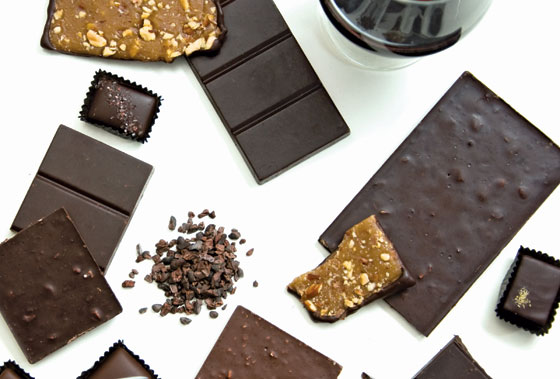Written by John Vitale
Theo handcrafted chocolate confections will turn a bottle of red wine into a fanciful celebration

JOE WHINNEY’S calling is about saving the planet as much as it is crafting richly sublime chocolate. Early in his career he traveled to Belize as a conservation volunteer where he worked on cocoa farms. His love for the rainforests and the people fueled his imagination to put an end to exploitative practices he saw were hurting the farmers and the land. So in 1994, Whinney became the first person ever to import organic cocoa beans (also called cacao beans) into the U.S and champion Fair Trade practices for the farmers he purchased from. By committing to fair wage pricing for the farmers, he knew it ensured him of getting the highest quality beans available.
Nearly seven years ago Whinney brought his career full circle and launched Theo Chocolate in Seattle’s Fremont district, one of only a handful of companies in the country that produce their own chocolate from cocoa bean to candy bar. All their beans are 100% organic and Fair Trade, grown sustainably around the world in places like Ecuador, Costa Rica, Peru, and the Congo.
CHOCOLATE TERROIR
Depending on where the beans are grown, chocolate has different flavor profiles. Borrowing a term from wine growers, it’s sort of like chocolate terroir. Just the same as Merlot grown in Washington doesn’t taste like Merlot grown elsewhere, the same holds true for chocolate. Differing soil, temperature, and rainfall amounts impart varying flavor nuances into the chocolate. Take for example, Theo’s Congo Vanilla Nib Dark Chocolate, which offers up woody, earthen flavors found only in African beans.
Other factors that affect flavor are fermentation, drying, and roasting techniques of the beans (yes, much like artisan coffee). Lastly, the greatest influence upon the finished chocolate is the percentage of cacao. Theo’s standard dark chocolate bars contain 70% cacao. It doesn’t take an experienced taster to discern the difference between mass produced major brands that contain only ten percent or less.
WINE & CHOCOLATE PAIRING
Dark and milk chocolates are better paired with red wines than white wines because the skins of red grapes impart tannins into the wine which give it a complex mouthfeel and drying, or puckering sensation.
Cocoa beans also contain tannins, along with a healthy dose of antioxidants. Together, they can be a sinfully delightful match.
There are no steadfast rules for wine and chocolate pairings, but here are a few basics:
1. First, taste the wine, then the chocolate, then the wine again, thus bringing all the flavors together in your mouth.
2. Pair light flavored chocolates with lighter bodied wines. Lighter doesn’t necessarily mean dark or milk chocolate, but refers to the overall ingredients in the chocolate. For example, Theo makes an elegantly silky dark chocolate ganache with flavors of fig and fennel that is lighter in overall taste than their milk chocolate Caffé Vita confection with its robust caramel and coffee flavors.
3. Pair wines that have the similar flavors found in the chocolate, such as cherry, smoky, earthy, fruity, floral, sweet or dry. Fortified wines such as Port are a common favorite because their bold structure and intense sweetness easily hold up to the chocolate.
4. Other times, a contrasting wine can accentuate hidden flavors in the chocolate, such as a dry Cabernet Sauvignon paired with a Theo cherry and almond bar to bring out the sweet fruit notes. The bottom line is to trust your palate and match up what you enjoy.
FIND THEO
Look for Theo Chocolate at wine tasting bars, bookshops, gourmet food retailers, as well as Bartell’s, Fred Meyer, PCC, and Whole Foods. Visit the website at TheoChocolate.com to order direct or find a store near you. Theo’s entire selection of confections and holiday specialties, along with daily tours of the chocolate factory, are available at 3400 Phinney Avenue North in Seattle.
